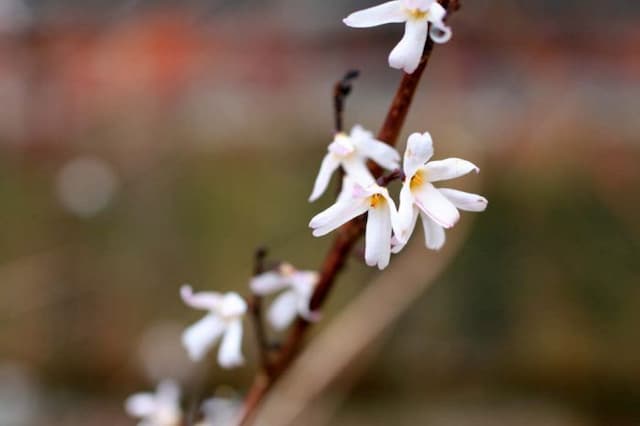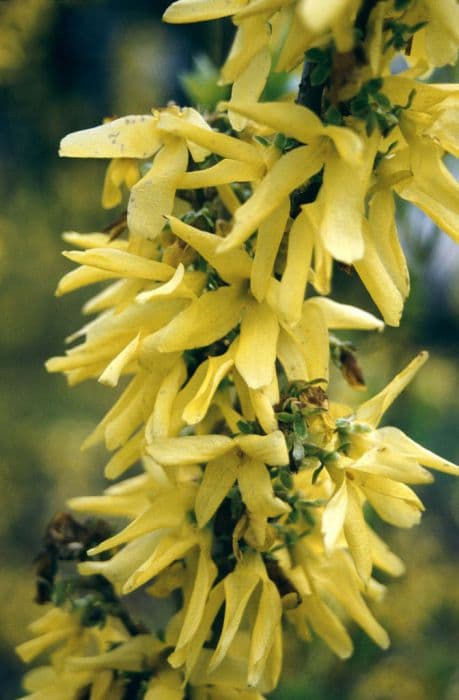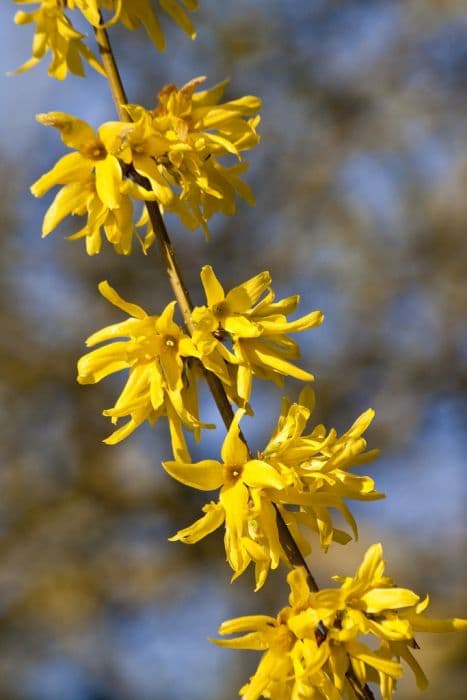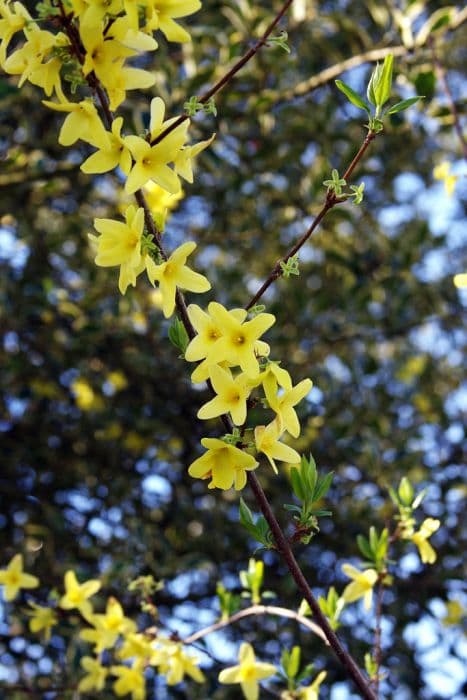Delavay Osmanthus Osmanthus delavayi
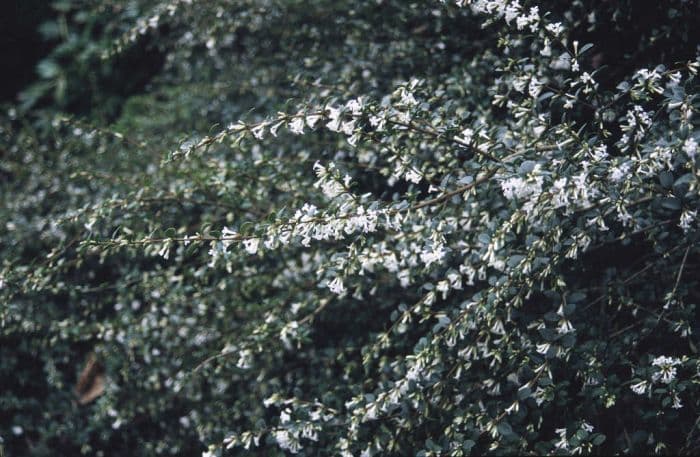
ABOUT
Osmanthus delavayi, commonly known as Delavay's osmanthus, is an evergreen shrub that is well-appreciated for its aesthetic appeal. It boasts a dense, rounded, and bushy growth habit. The branches are cloaked in small, leathery leaves that are dark green on top with a paler underside. They are oval-shaped with subtle serrations on the edges, giving the foliage a fine-textured look. One of the most striking features of Delavay's osmanthus is its fragrant blooms. The plant produces clusters of small, white flowers that resemble tiny bells or jasmine-like in shape. These blossoms can cover the shrub so profusely that they almost completely hide the foliage when viewed from a distance, creating a stunning display. The flowers emit a sweet, enchanting fragrance that can fill the surrounding air, especially during the evening and early morning. After flowering, Delavay's osmanthus may produce small, blue-black fruits, which are oval and attract birds and other wildlife. Overall, the plant presents itself with a refined and elegant appearance, making it a popular choice for ornamental gardens and landscapes where it's used for hedging, as a specimen plant, or even in mixed borders where its aromatic flowers can be fully appreciated.
About this plant
 Names
NamesSynonyms
Delavay Osmanthus, Delavay Tea Olive, Delavay's Osmanthus.
Common names
Osmanthus delavayi Franch.
 Toxicity
ToxicityTo humans
Sweet olive, as Osmanthus delavayi is commonly known, does not have a notable record of toxicity to humans. In general, this plant is not considered poisonous and does not cause severe symptoms if accidentally ingested. However, it's always advisable to exercise caution and keep all plants out of reach of young children who might chew on them, as individual reactions to plants can vary.
To pets
Sweet olive is not known to be toxic to pets. There is no significant evidence to suggest that Osmanthus delavayi causes poisoning in animals such as cats and dogs. It is not listed among the commonly recognized poisonous plants for household pets. Nonetheless, it is always best to prevent pets from eating plants, as they could cause stomach upset or an allergic reaction in sensitive individuals.
 Characteristics
CharacteristicsLife cycle
Perennials
Foliage type
Evergreen
Color of leaves
Green
Flower color
White
Height
6-8 feet (1.8-2.4 meters)
Spread
4-6 feet (1.2-1.8 meters)
Plant type
Shrub
Hardiness zones
7
Native area
China
Benefits
 General Benefits
General Benefits- Aesthetic Appeal: Osmanthus delavayi, commonly known as Delavay osmanthus, has attractive evergreen foliage and small, fragrant flowers that enhance garden aesthetics.
- Landscape Versatility: It is suitable for a variety of landscaping uses, including hedges, screens, or specimen plantings.
- Wildlife Attraction: The flowers provide nectar for pollinators such as bees and butterflies, supporting local ecosystems.
- Low Maintenance: Once established, Delavay osmanthus requires minimal care, making it an ideal plant for low-maintenance gardens.
- Drought Tolerance: It is relatively drought-tolerant, which is useful for xeriscaping or in regions with water scarcity.
- Cold Hardiness: Delavay osmanthus can withstand cooler temperatures, making it suitable for temperate climates.
- Scented Garden: The sweet fragrance of its flowers adds a sensory dimension to gardens, especially enjoyable in the spring.
 Medical Properties
Medical PropertiesThis plant is not used for medical purposes.
 Air-purifying Qualities
Air-purifying QualitiesThis plant is not specifically known for air purifying qualities.
 Other Uses
Other Uses- Osmanthus delavayi, commonly known as Delavay's osmanthus, can be infused in liquors to impart a delicate floral fragrance and subtle sweetness to beverages.
- This plant's wood is valued for its durability and pleasant scent, making it suitable for crafting small decorative objects or wooden jewelry.
- The fragrant blossoms of Delavay's osmanthus are sometimes used to enhance the aroma of natural perfumes and scented sachets.
- Floriculture enthusiasts may use the flowers of this plant for potpourri, combining them with other botanical elements to create a long-lasting room fragrance.
- In some cultural ceremonies or traditions, the branches and blooms might be used as symbols of good fortune or as part of festive decorations.
- Artisans may incorporate the dried flowers into papermaking, embedding them into the pulp to create decorative and scented paper products.
- The plant can serve as a nectar source for bees; thus, it potentially contributes to the production of uniquely flavored honey.
- As an ornamental, Delavay's osmanthus can be grown for bonsai, where its small leaves and attractive growth pattern are especially valued.
- Culinary experimentation has led to the use of its blossoms in unique ice cream or dessert recipes to add a novel flavor twist.
- In fabric dyeing, the flowers might be used to achieve subtle dye colors, although this application is not commonly practiced.
Interesting Facts
 Feng Shui
Feng ShuiThe Sweet Olive is not used in Feng Shui practice.
 Zodiac Sign Compitability
Zodiac Sign CompitabilityThe Sweet Olive is not used in astrology practice.
 Plant Symbolism
Plant Symbolism- Romantic Love - Sweet osmanthus, with its fragrant blossoms, is commonly associated with love and romance in Chinese culture, often representing a sense of affection and tenderness in relationships.
- Good Fortune - In East Asia, the sweet osmanthus is symbolic of good luck and prosperity. It is believed to bring positive energy and is often used in festive occasions for this reason.
- Peace - The plant is also seen as a symbol of peace due to its calming fragrance which is thought to induce tranquility and harmony within a space.
- Nobility - In traditional contexts, the sweet osmanthus can represent nobility and dignity, possibly due to its pleasant aroma and the visual appeal of its flowers.
 Water
WaterDelavay Osmanthus prefers to be kept in evenly moist soil, so regular watering is necessary. During the growing season (spring and summer), water the plant once a week with approximately 2 gallons per 10 square feet of planting area. Reduce watering frequency to every two weeks in the fall and winter when the plant is not actively growing. Ensure that the soil drains well to prevent waterlogging, as this plant is sensitive to overwatering. Adjust the amount of water and frequency depending on rainfall and the temperature, as plants need more water during hotter, drier periods.
 Light
LightSweet Olive, commonly known as Delavay Osmanthus, thrives in full sunlight to partial shade. Ideal conditions include receiving at least four to six hours of direct sunlight daily, but the plant can also tolerate dappled sunlight throughout the day. Protect it from intense afternoon sun by situating it where it can receive morning light and afternoon shade, or in a location that gets filtered sunlight.
 Temperature
TemperatureDelavay Osmanthus, or Sweet Olive, is best suited to temperate climates, with ideal temperatures ranging between 60°F and 80°F. It can withstand minimum temperatures down to around 10°F but should be protected from prolonged freezing conditions. Sweet Olive generally favors warmer temperatures and may struggle to thrive if temperatures consistently fall outside this ideal range.
 Pruning
PruningPrune your Sweet Olive, or Delavay Osmanthus, to maintain its shape and to encourage dense, bushy growth. Pruning is best done in late winter or early spring before new growth begins. Remove any dead, damaged, or crossing branches, and cut back up to one-third of the oldest stems to promote new shoots. Pruning can be undertaken every year or every other year, depending on the desired size and shape of the plant.
 Cleaning
CleaningAs needed
 Soil
SoilSweet Olive thrives in well-draining soil with a pH of 5.5 to 7.5. A mix of two parts garden soil, one part peat moss, and one part perlite or sand is ideal to ensure good drainage and aeration. Regularly check the pH to maintain optimal soil conditions for the plant's health.
 Repotting
RepottingDelavay Osmanthus should be repotted every 2 to 3 years in spring. If growth has slowed, it may be time to repot. Choose a container that's slightly larger than the existing one to provide space for roots to grow.
 Humidity & Misting
Humidity & MistingDelavay Osmanthus prefers moderate to high humidity levels, ideally between 40-60%. If indoor air is too dry, consider using a humidifier or placing a tray of water near the plant to increase local humidity.
 Suitable locations
Suitable locationsIndoor
Place Sweet Olive near bright, indirect light and maintain humidity.
Outdoor
Plant Sweet Olive in partial shade and protect from harsh winds.
Hardiness zone
7-9 USDA.
 Life cycle
Life cycleDelavay Osmanthus begins its lifecycle as a seed, which once sown in fertile, well-drained soil and with the right conditions, will germinate and develop into a seedling. This hardy evergreen shrub then enters a vegetative stage, growing leaves and branches and forming a bushy structure. As the plant reaches maturity, it produces fragrant white flowers, typically in late winter to early spring, which are then pollinated by insects. Following pollination, the shrub subsequently bears small blue-black fruits. Delavay Osmanthus has a perennial growth cycle, with the ability to live and flower for many years. Pruning and general care throughout its life can encourage healthier growth and prolific flowering.
 Propogation
PropogationPropogation time
Spring to Summer
The most popular method of propagating the Osmanthus delavayi, commonly known as the Delavay osmanthus, is by semi-ripe cuttings. These cuttings are best taken in late summer when the new growth has begun to harden. Cuttings should be about 4 to 6 inches long and include several leaves. The lower part of the cutting, which will be inserted into the soil, must be stripped of its leaves. These cuttings can be dipped in a rooting hormone to encourage root growth before being placed in a well-draining potting mixture. The pot should then be covered with a plastic bag or placed in a propagator to maintain high humidity around the cuttings until they root. This process usually takes several weeks, after which the new plants can be gradually acclimatized to less humid conditions before planting out.
